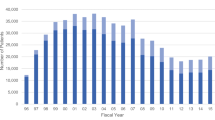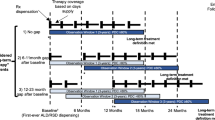Abstract
Summary
We identified significantly slower uptake, and consistently lower proportions of new oral bisphosphonate formulations dispensed in rural regions compared to urban regions of Ontario. Further research examining regional differences in outcomes may provide insight as to whether urban–rural differences in prescribing translate into health disparities between regions.
Purpose
The aim of this study was to examine urban–rural differences in the uptake of new oral bisphosphonate formulations available on the Ontario drug formulary: alendronate + vitamin D3 (January 2007), monthly risedronate (June 2009), and risedronate delayed-release (February 2012).
Methods
We plotted the monthly proportion of new formulation claims of all claims with the same drug molecule, from their formulary listing date until March 2014. Results were stratified by major urban, nonmajor urban, and rural regions as defined by the Rurality Index of Ontario. We compared the rate of uptake over the first year of formulary availability using linear regression, and compared proportions dispensed between regions using chi-squared tests.
Results
We identified a regional gradient in uptake for alendronate + vitamin D3 and monthly risedronate; major urban regions had the fastest uptake, followed by nonmajor urban regions, and rural regions had the slowest uptake. Rural regions also had the slowest uptake of risedronate delayed-release; however, uptake in major urban and nonmajor urban regions were similar. Rural regions dispensed the lowest proportions for all new formulations 1 year after formulary availability: alendronate + vitamin D3 (32 % major urban, 23 % nonmajor urban, 12 % rural), monthly risedronate (26 % major urban, 21 % nonmajor urban, 16 % rural), and risedronate delayed-release (21 % major urban, 22 % nonmajor urban, 13 % rural). This pattern persisted throughout our study.
Conclusion
We identified significantly slower uptake and lower proportions of new formulations dispensed in rural regions compared to urban regions. Further research examining regional differences in outcomes may demonstrate whether urban–rural differences in prescribing translate into health disparities between regions.




Similar content being viewed by others
References
Dagenais P, Vanasse A, Courteau J, Orzanco MG, Asghari S (2010) Disparities between rural and urban areas for osteoporosis management in the province of Quebec following the Canadian 2002 guidelines publication. J Eval Clin Pract 16:438–444
Morgan SG, Cunningham CM, Hanley GE (2010) Individual and contextual determinants of regional variation in prescription drug use: an analysis of administrative data from British Columbia. PLoS One 5: e15883
Pohar SL, Majumdar SR, Johnson JA (2007) Health care costs and mortality for Canadian urban and rural patients with diabetes: population-based trends from 1993–2001. Clin Ther 29:1316–1324
Cutts C, Tett SE (2003) Influences on doctors’ prescribing: is geographical remoteness a factor? Aust J Rural Health 11:124–130
Cutts C, Tett SE (2003) Doctors perceptions of the influences on their prescribing: a comparison of general practitioners based in rural and urban Australia. Eur J Clin Pharmacol 58:761–766
Alkhateeb FM, Khanfar NM, Clauson KA (2009) Characteristics of physicians who frequently see pharmaceutical sales representatives. J Hosp Mark Public Relations 19:2–14
Sondergaard J, Vach K, Kragstrup J, Andersen M (2009) Impact of pharmaceutical representative visits on GPs’ drug preferences. Fam Pract 26:204–209
Prosser H, Almond S, Walley T (2003) Influences on GPs’ decision to prescribe new drugs—the importance of who says what. Fam Pract 20:61–68
Ontario Ministry of Health and Long-Term Care (2014) Formulary Search: Ontario Drug Benefit Formulary/Comparative Drug Index. https://www.healthinfo.moh.gov.on.ca/formulary/index.jsp Accessed April 15 2014
Heaney RP (2006) Alendronate plus cholecalciferol for the treatment of osteoporosis. Womens Health (Lond Engl) 2:23–27
Recker R, Lips P, Felsenberg D et al (2006) Alendronate with and without cholecalciferol for osteoporosis: results of a 15-week randomized controlled trial. Curr Med Res Opin 22:1745–1755
Ralston SH, Binkley N, Boonen S, Kiel DP, Reginster JY, Roux C, Chen L, Rosenberg E, Santora A (2011) Randomized trial of alendronate plus vitamin D3 versus standard care in osteoporotic postmenopausal women with vitamin D insufficiency. Calcif Tissue Int 88:485–494
Wilkes MM, Navickis RJ, Chan WW, Lewiecki EM (2010) Bisphosphonates and osteoporotic fractures: a cross-design synthesis of results among compliant/persistent postmenopausal women in clinical practice versus randomized controlled trials. Osteoporos Int 21:679–688
Cramer JA, Amonkar MM, Hebborn A, Altman R (2005) Compliance and persistence with bisphosphonate dosing regimens among women with postmenopausal osteoporosis. Curr Med Res Opin 21:1453–1460
Simon JA, Lewiecki EM, Smith ME, Petruschke RA, Wang L, Palmisano JJ (2002) Patient preference for once-weekly alendronate 70 mg versus once-daily alendronate 10 mg: a multicenter, randomized, open-label, crossover study. Clin Ther 24:1871–1886
Reid DM (2006) Once-monthly dosing: an effective step forward. Bone 38:S18–S22
Maeda SS, Lazaretti-Castro M (2014) An overview on the treatment of postmenopausal osteoporosis. Arquivos brasileiros de endocrinologia e metabologia 58:162–171
Pazianas M, Abrahamsen B, Ferrari S, Russell RG (2013) Eliminating the need for fasting with oral administration of bisphosphonates. Ther Clin Risk Manag 9:395–402
McClung MR, Miller PD, Brown JP et al (2012) Efficacy and safety of a novel delayed-release risedronate 35 mg once-a-week tablet. Osteoporos Int 23:267–276
Burden AM, Paterson JM, Gruneir A, Cadarette SM (2015) Adherence to osteoporosis pharmacotherapy is underestimated using days supply values in electronic pharmacy claims data. Pharmacoepidemiol Drug Saf 24:67–74
Ontario Ministry of Health and Long-Term Care (2012) Health Analyst’s Toolkit. Queen’s Printer for Ontario, Toronto
Jaakkimainen RL, Sood PR, Schultz SE (2012) Office-based procedures among urban and rural family physicians in Ontario. Can Fam Physician 58:e578–e587
SAS (1993) SAS/ETS User’s Guide, Version 6, 2nd edn. SAS Institute Inc, Cary, NC
Ontario Ministry of Health and Long-Term Care (2014) The Ontario Drug Benefit (ODB) Program. http://www.health.gov.on.ca/en/public/programs/drugs/programs/odb/odb.aspx Accessed February 7 2014
Fraser LA, Albaum JM, Tadrous M, Burden AM, Shariff SZ, Cadarette SM (2015) Patterns of use for brand-name versus generic oral bisphosphonate drugs in Ontario over a 13-year period: a descriptive study. CMAJ open 3:E91–E96
Cramer JA, Gold DT, Silverman SL, Lewiecki EM (2007) A systematic review of persistence and compliance with bisphosphonates for osteoporosis. Osteoporos Int 18:1023–1031
Health Force Ontario (2014) Practicing in Ontario: Locum. http://www.healthforceontario.ca/en/Home/Physicians/Training_%7C_Practising_in_Ontario/Locum Accessed June 17 2014
Shrank WH, Cox ER, Fischer MA, Mehta J, Choudhry NK (2009) Patients’ perceptions of generic medications. Health Aff (Millwood) 28:546–556
Behan K, Cutts C, Tett SE (2005) Motivations and perceived influences on rural and urban general practitioners when prescribing conventional non-steroidal anti-inflammatory drugs or COX-2 inhibitors. J Clin Pharm Theraps 30:337–343
Minore B, Hill ME, Pugliese I, Gauld T (2008) Rurality Literature Review. Centre for Rural and Northern Health Research, Thunder Bay
Ontario Rheumatology Association (2015) Limited use codes for zoledronic acid and denosumab. http://ontariorheum.ca/drug-forms-and-codes/limited-use-codes Accessed December 9 2015
Burden AM, Tadrous M, Calzavara A, Cadarette SM (2015) Uptake and characteristics of zoledronic acid and denosumab patients and physicians in Ontario, Canada: impact of drug formulary access. Osteoporos Int 26:1525–1533
Levy AR, O’Brien BJ, Sellors C, Grootendorst P, Willison D (2003) Coding accuracy of administrative drug claims in the Ontario Drug Benefit database. Can J Clin Pharmacol 10:67–71
Paterson JM, Suleiman A, Hux JE, Bell C (2008) How complete are drug history profiles that are based on public drug benefit claims? Can J Clin Pharmacol 15:e108–e116
Stocks N, Ryan P, Allan J, Williams S, Willson K (2009) Gender, socioeconomic status, need or access? Differences in statin prescribing across urban, rural and remote Australia. Aust J Rural Health 17:92–96
Clark RA, Eckert KA, Stewart S, Phillips SM, Yallop JJ, Tonkin AM, Krum H (2007) Rural and urban differentials in primary care management of chronic heart failure: new data from the CASE study. Med J Aust 186:441–445
Acknowledgments
This research was supported by an Ontario Ministry of Research and Innovation Early Researcher Award held by Dr. Suzanne Cadarette. Dr. Cadarette was supported by a Canadian Institutes of Health Research (CIHR) New Investigator Award (MSH-95364), and Racquel Jandoc received support from the CIHR Training Program in Bridging Scientific Domains for Drug Safety and Effectiveness, and a Leslie Dan Faculty of Pharmacy Clinical, Social, and Administrative Pharmacy Professor’s Award to support analyses. This study was completed as part of Racquel Jandoc’s MSc thesis and was presented at the Canadian Society for Epidemiology and Biostatistics Annual Conference in Mississauga, Ontario, Canada, June 2015, and the International Conference for Pharmacoepidemiology and Therapeutic Risk Management in Boston, MA, USA, August 2015. Authors thank Andrea M. Burden, PhD, University of Toronto, and Mina Tadrous, PharmD, PhD, University of Toronto, for insightful discussions, and IMS Brogan Inc. for use of their Drug Information Database .
Parts of this material are based on data and information compiled and provided by the Canadian Institute for Health Information (CIHI). However, the analyses, conclusions, opinions, and statements expressed herein are those of the author, and not necessarily those of CIHI. All analyses were completed at the Institute for Clinical Evaluative Sciences (ICES) University of Toronto satellite site, with support from the Leslie Dan Faculty of Pharmacy, University of Toronto. ICES is a nonprofit research corporation funded by the Ontario Ministry of Health and Long-Term Care (MOHLTC). The opinions, results, and conclusions herein are those of the authors and are independent from the funding sources. No endorsement by CIHR, ICES, or the MOHLTC should be inferred.
Author information
Authors and Affiliations
Corresponding author
Ethics declarations
Conflicts of interest
None.
Appendix
Appendix
Rights and permissions
About this article
Cite this article
Jandoc, R., Mamdani, M., Lévesque, L.E. et al. Urban–rural differences in the uptake of new oral bisphosphonate formulations. Arch Osteoporos 11, 11 (2016). https://doi.org/10.1007/s11657-016-0261-8
Received:
Accepted:
Published:
DOI: https://doi.org/10.1007/s11657-016-0261-8






